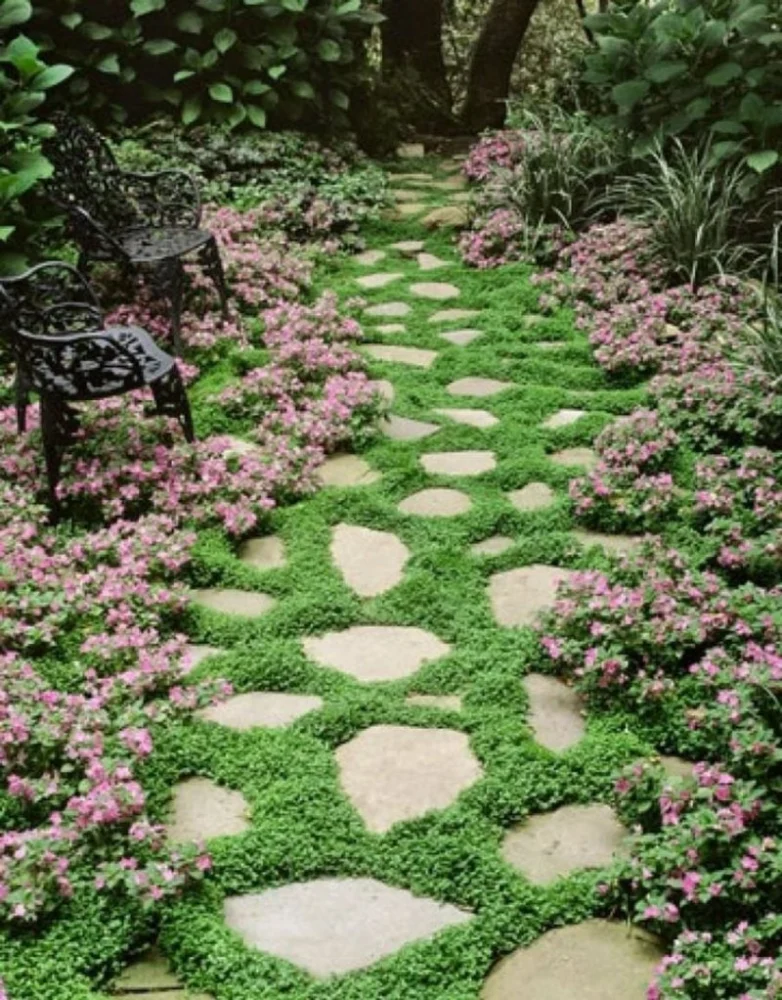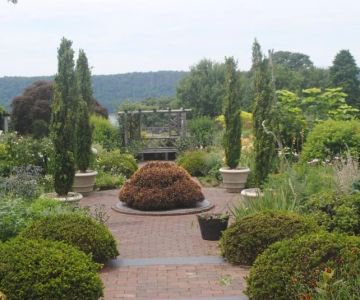
1. Why Perennial Borders Are Perfect for Framing Walkways
When designing a garden, one of the most important aspects is how the walkway interacts with the landscape. Perennial borders offer a practical and beautiful way to frame walkways, providing both structure and color throughout the year. Unlike annual plants that need to be replanted every season, perennials bloom year after year, making them a cost-effective and low-maintenance choice for framing your garden paths. In this article, we’ll explore the benefits of using perennial borders, offer design ideas, and share tips for planting and maintaining them effectively.
2. Benefits of Using Perennials for Borders
Perennial borders are not only visually appealing but also offer a range of benefits when used to frame walkways. Here are some reasons why perennials are ideal for this purpose:
2.1 Low Maintenance
One of the key advantages of perennial plants is their ability to return every year without needing to be replanted. Once established, perennial borders require minimal care, especially when compared to annuals. This makes them a great choice for busy gardeners or those who prefer a low-maintenance garden.
2.2 Year-Round Interest
Perennials provide color and texture throughout the year. While many annuals bloom for just one season, perennials like daylilies, hostas, and coneflowers bloom in varying seasons, meaning your walkway borders can look stunning year-round. Additionally, many perennials feature unique textures and foliage that add visual interest even during the off-season.
2.3 Eco-Friendly and Sustainable
Perennial plants are also eco-friendly. By choosing native perennials, you can help support local wildlife, such as bees and butterflies, that rely on native plants for food and habitat. Additionally, perennials help prevent soil erosion and improve water retention, which can be especially beneficial if you're looking for sustainable landscaping options.
3. Designing with Perennial Borders for Walkways
Designing perennial borders to frame your walkways can be a fun and rewarding project. Below, we explore how to create visually pleasing and functional borders that will enhance your walkway’s appeal:
3.1 Choose the Right Plants for Your Walkway Border
Choosing the right perennials is essential for ensuring that your walkway border thrives and adds to the overall aesthetic of your garden. Here are some tips for selecting the best plants:
- Consider Height and Spread: Choose perennials that fit the scale of your walkway. Taller plants can go in the back of the border, while shorter varieties should be planted in the front. This layering effect creates depth and visual interest.
- Blooming Seasons: Select a mix of perennials that bloom at different times of the year to ensure color and interest across seasons. For example, combine early bloomers like crocuses with late-season flowers like asters.
- Foliage Texture: Incorporate plants with interesting textures, such as the large leaves of hostas or the fine foliage of ferns, to add variety even when flowers aren't in bloom.
3.2 Plan for Maintenance
While perennials are low-maintenance, some varieties still require occasional care. When planning your perennial border, make sure to consider the plants’ care requirements, such as cutting back dead stems, thinning overcrowded plants, or dividing perennials every few years to maintain healthy growth. Group plants with similar maintenance needs together to simplify upkeep.
3.3 Create a Variety of Textures and Heights
To make your walkway border visually dynamic, combine perennials with different textures and heights. Tall plants like delphiniums or foxgloves can add vertical interest, while ground covers like creeping thyme or ajuga can fill in lower areas, offering a lush, textured carpet. Combining plants with varying shapes, colors, and textures will create a beautiful, cohesive design that complements your walkway.
4. Popular Perennials for Bordering Walkways
Here are some of the best perennial plants to consider for your walkway borders, each offering unique beauty and benefits:
4.1 Lavender
Lavender is a favorite for its fragrant flowers and attractive silvery-green foliage. It thrives in well-drained soil and can handle full sun, making it perfect for sunny walkways. The added bonus is that lavender attracts pollinators like bees and butterflies, adding an eco-friendly touch to your garden.
4.2 Daylilies
Daylilies are hardy perennials that come in a wide range of colors. They’re perfect for adding vibrant blooms to your walkway and require little maintenance once established. Daylilies are also known for their ability to tolerate a variety of soil conditions and are resistant to pests, making them a practical choice for many gardeners.
4.3 Hostas
Hostas are ideal for shady walkways, with their broad, lush leaves adding texture and a calming, green presence. While they don’t produce dramatic flowers, their foliage comes in a variety of colors and patterns, from dark green to variegated whites and yellows. Hostas are also low-maintenance and will thrive in shaded areas where many other plants won’t grow well.
4.4 Coneflowers
Coneflowers (Echinacea) are hardy, drought-tolerant perennials that produce large, daisy-like flowers in shades of purple, pink, and white. They attract pollinators and are a wonderful addition to any walkway border, offering bright color in the summer months. Coneflowers are low-maintenance and can withstand a range of growing conditions.
5. Maintaining Your Perennial Border
Once your perennial border is established, regular maintenance ensures it continues to thrive. Here’s how to keep your perennial border looking its best:
5.1 Watering and Fertilizing
While perennials are relatively drought-tolerant, they still require regular watering, especially during dry spells. Water deeply to encourage strong root development, but avoid overwatering, which can lead to root rot. Fertilize your plants annually in early spring to promote healthy growth and vibrant blooms throughout the season.
5.2 Pruning and Cutting Back
After the blooming season, prune dead or faded flowers to encourage new growth and improve the overall appearance of your border. In late fall or early spring, cut back the stems of certain perennials like hostas or daylilies to keep the border tidy and ready for the next growing season.
5.3 Dividing Plants
Every few years, many perennials benefit from being divided to keep them healthy and to encourage more blooms. Dividing overcrowded plants ensures they have enough space to grow and prevents them from becoming too leggy. Early spring or fall is the best time for dividing most perennials.
6. Where to Find the Best Garden Supplies
If you're ready to get started on your perennial borders and need high-quality plants, soil, or gardening tools, visit Beautiful Landscapes for a wide selection of products to enhance your garden. They offer everything you need to create beautiful, lasting garden borders and walkways, from perennials to expert gardening advice. Visit them today to find the perfect plants and tools for your next landscaping project.









 Wood Lawn Care Inc4.0 (9 reviews)
Wood Lawn Care Inc4.0 (9 reviews) Aurelio Landscaping3.0 (7 reviews)
Aurelio Landscaping3.0 (7 reviews) De Ruiter Lawn Equipment4.0 (39 reviews)
De Ruiter Lawn Equipment4.0 (39 reviews) Freedom StoneMakers/ Freedom Lawn Maintenance Inc.3.0 (3 reviews)
Freedom StoneMakers/ Freedom Lawn Maintenance Inc.3.0 (3 reviews) C & B Landscaping, LLC5.0 (7 reviews)
C & B Landscaping, LLC5.0 (7 reviews) Antiquescapes5.0 (8 reviews)
Antiquescapes5.0 (8 reviews) 7 Steps to Create a Pollinator Garden That Attracts Bees & Butterflies
7 Steps to Create a Pollinator Garden That Attracts Bees & Butterflies How Much Value Does Landscaping Add to a Home? Explore the Benefits and Impact
How Much Value Does Landscaping Add to a Home? Explore the Benefits and Impact How to Landscape With Ornamental Edibles for Dual Use
How to Landscape With Ornamental Edibles for Dual Use How to Build a Stone Pathway With a Natural Flow
How to Build a Stone Pathway With a Natural Flow How to Build a Wildlife Habitat Garden That Supports Biodiversity
How to Build a Wildlife Habitat Garden That Supports Biodiversity How to Plan an Entryway Garden That Welcomes Guests: Design Tips and Ideas
How to Plan an Entryway Garden That Welcomes Guests: Design Tips and Ideas